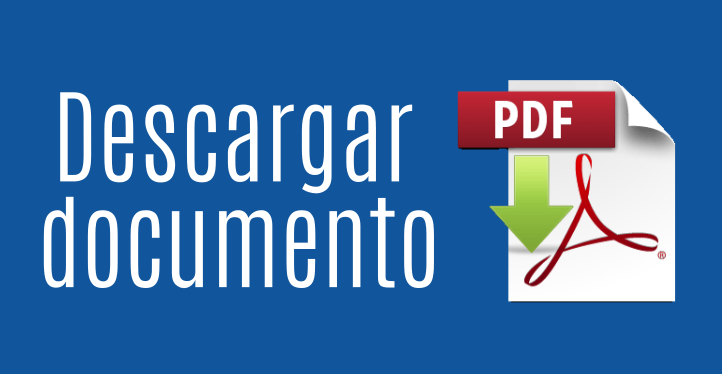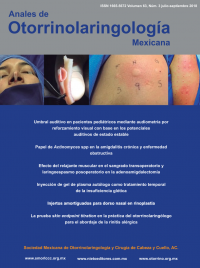Injection of autologous plasma gel as temporal treatment of glottic insufficiency.
An Orl Mex. 2018 julio-septiembre;63(3):107-114.
Natalia Montemayor-Peña,1 Gabriela Cordero-Olmos,1 Ana Gabriela Saavedra-Mendoza,1 Matsuharu Akaki-Caballero,2 Mauricio González-Avante,3 Rosalba Carmona-García4
1 Otorrinolaringólogo y cirujano de cabeza y cuello. Alta especialidad en Laringología y Fonocirugía, UNAM. Clínica de Laringología y Fonocirugía.
2 Otorrinolaringólogo y cirujano de cabeza y cuello. Subespecialidad en Laringología y Fonocirugía, Sao Paulo, Brasil. Jefe de la Sección Médica en Otorrinolaringología. Profesor titular del Alta Especialidad en Laringología y Fonocirugía, UNAM.
3 Jefe del Servicio de Banco de Sangre.
4 QFB adscrita al Servicio de Banco de Sangre.
Centro Médico Nacional 20 de Noviembre, ISSSTE, Ciudad de México.
Resumen
OBJETIVO: Analizar subjetiva y objetivamente los resultados posteriores a la inyección de gel de plasma autólogo en pacientes con insuficiencia glótica.
MATERIAL Y MÉTODO: Estudio prospectivo, observacional, descriptivo, longitudinal, en el que se incluyeron pacientes con disfonía secundaria a insuficiencia glótica atendidos en la Clínica de Laringología y Fonocirugía del Centro Médico Nacional 20 de Noviembre, ISSSTE, de agosto a diciembre de 2014. Se registraron tres valoraciones: cuestionario del índice de discapacidad vocal de 10 ítems (IDV-10), tiempo máximo de fonación (TMF) y videolaringoestroboscopia previo a la inyección. Se elaboró gel de plasma para su posterior inyección percutánea a través de la membrana tirohioidea. Se valoró a las cuatro y ocho semanas.
RESULTADOS: Se incluyeron seis pacientes del sexo femenino, con edad promedio de 67 años. Se observó diferencia estadísticamente significativa entre el IDV-10 preintervención, 4 y 8 semanas posaplicación (p < 0.002), así como el tiempo de fonación máximo basal y 4 y 8 semanas después (p < 0.001). Por videolaringoestroboscopia se observó cierre glótico completo en el 100% de la muestra a las cuatro semanas y en 67% de las pacientes a las ocho semanas. El 33% restante de los pacientes continuó con menor insuficiencia glótica.
CONCLUSIONES: La medialización con inyección de gel de plasma autólogo es una opción útil de tratamiento temporal en pacientes con insuficiencia glótica.
PALABRAS CLAVE: Laringoplastia.
Abstract
OBJECTIVE: To analyze subjective and objectively the results after the injection of autologous plasma gel in patients with glottic insufficiency.
MATERIAL AND METHOD: A prospective, observational, descriptive and longitudinal study was done in patients with dysphonia secondary to glottal insufficiency attended at the Laryngology and Phonosurgery Clinic of the CMN 20 de Noviembre, ISSSTE, Mexico, from August to December 2014. There were three assessments: by de 10-item Voice Handicap Index questionnaire (VHI-10), maximum phonation time (MPT) and laryngovideostroboscopy prior to injection. The sample for the plasma gel preparation was taken with the posterior percutaneous injection through the thyrohyoid membrane. The same evaluations were applied at 4 and 8 weeks after the intervention.
RESULTS: Six female patients were included with average age of 67 years. A statistically significant difference was observed between the pre-intervention VHI-10 and at 4 and 8 weeks after application (p < 0.002), as well as the MPT before and at 4 and 8 weeks (p < 0.001). By laryngovideostroboscopy was observed a complete glottic closure in 100% of the sample at 4 weeks and in 67% of patients at 8 weeks; 33% of the remaining patients continued with lower glottic insufficiency.
CONCLUSION: Autologous plasma gel medialization injection is a useful option for temporary treatment in patients with glottic insufficiency.
KEYWORDS: Laryngoplasty.


